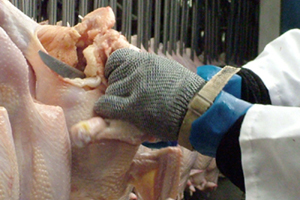NCC defends US poultry processing techniques

“Food safety is our top priority and we rely on the latest and best science to continuously improve our products and constantly strive to decrease the risk of potential foodborne pathogens,” said National Chicken Council Vice President of Scientific and Regulatory Affairs Ashley Peterson in response to a recent Washington Post article that conveyed concerns regarding the use of processing aids in the poultry industry.
“We are at war with Salmonella and Campylobacter, and we use every approved tool at our disposal to kill bacteria on chicken products to reduce the risk of foodborne illness,” Peterson said. “Our customers and consumers expect nothing less.”
Some of those tools include antimicrobials used as processing aids that are applied to poultry carcasses to kill foodborne pathogens. Two common processing aids that were mentioned by the Washington Post are cetylpyridinium chloride (CPC) and peracetic acid (PAA).
CPC is an antiseptic that kills bacteria and other microorganisms. It is commonly found in toothpaste, mouthwash and nasal sprays.
Peracetic acid (PAA) is an organic compound, made up of basically vinegar and hydrogen peroxide. It is applied to poultry carcasses at concentrations that are less acidic and more dilute than products commonly found in kitchen cabinets and refrigerators. Within the water at poultry processing plants, poultry is treated at concentrations that are less acidic than lemon juice and more dilute than household vinegar.
“The bottom line for consumers is that these processing aids are diluted significantly, break down in water to non-harmful substances and are often rinsed-off after their application. “They have no impact on public health other than to make chicken products safer.”
Peterson refuted some of the claims made in the article regarding the “neutralization” of certain processing aids by noting that companies that manufacture these processing aids do extensive research and must document their safety and effectiveness before any product is approved for use by FDA and USDA; she said this evaluation is frequently repeated by others in the industry.
“USDA-approved processing aids by definition have no lasting effect after application,” Peterson continued. “As such, we are confident that testing results are indicative of effective chemistry.”













